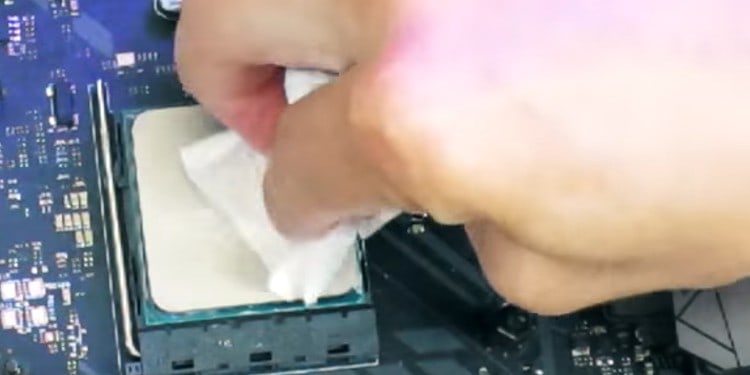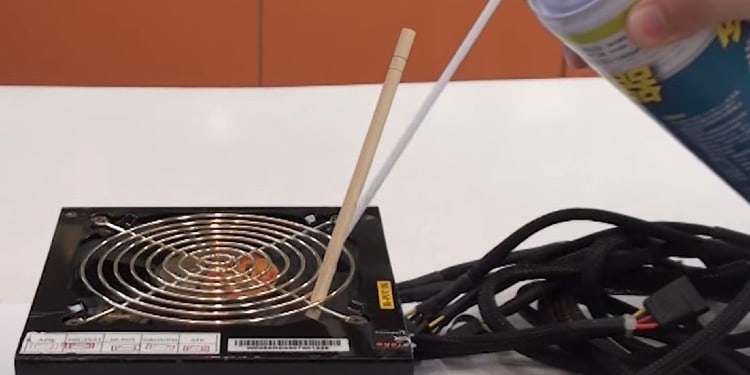Things To Know Before Cleaning Your PC
We have listed a few basic cleaning tips that will help you clean any electrical devices.
How to Clean Dust From PC?
First, make sure you have unplugged your computer from the wall outlet. Press the power button six to seven times to drain any charge left on some capacitor in your motherboard. Wait about half an hour for your components to cool down if your computer is running for a long time before cleaning. Once you have done this, continue with the following steps.
Unplug All Power Cables And Remove All Add-ins from the Motherboard
To perform a deep clean, remove all the cables. This will make your job a lot easier. You can take some pictures of the cables before removing them to remember where the cables belong. Also, remove all your add-in components from the motherboard like graphic cards, RAM sticks, NVMe SSD, CPU cooler, the processor. You can also take multiple pictures of all your motherboard so that you know where each component belongs. You can remove all add-ins easily except for the CPU cooler and the processor. To remove the CPU cooler, unscrew all four pins on the four sides of the corner. Cooler getting stuck in the processor is a common issue. If you cannot remove the cooler, it is because of the thermal paste. When the thermal paste is cold, it can act like glue. You need to heat the CPU so that the thermal paste gets a little warm. To make it warm, you can just turn your PC on for a few minutes and turn it off again.
Cleaning And Removing the Processor From the Motherboard
Before you remove the processor, clean all the thermal paste on it. To clean your thermal paste, use a dry tissue or a small piece of lint-free cloth to wipe it off. Then, use rubbing alcohol to clean the excess thermal paste. Be sure to clean small left-over thermal paste around the processor socket. The left-over thermal paste on your motherboard can damage your motherboard when turned on. For AMD Processors: If you have an AMD processor, you won’t have any hassle with removing it. Since there are no pins on the AMD processor, you can just pull the silver-metal lever on one side of the processor socket. For Intel Processors: If you have an old-generation intel processor, your processor will have hundreds of pins. Be very careful while removing them, as one bent pin may damage the entire processor. You can pull the silver-metal lever on one side of the processor socket. Now, gently remove the processor. You will not have a problem if you have a newer generation Intel processor, as they won’t have any pins on them.
Clean the Motherboard
Because of its size, we usually start with the motherboard. You may or may not remove the motherboard from the case while cleaning it. If you want to be thorough, unscrew all the attached screws attaching your motherboard to the CPU case. To remove dust particles from your motherboard, you can either use a can of compressed air or a blower. We recommend using a can of compressed air instead of a blower, as it can clean specks of dust in the corner of your motherboard. Avoid using a vacuum to clean your motherboard. If you are using a blower, make sure there are no loose components lying in your motherboard. Be sure that all slots and ports like RAM slots, PCIe slot, I/O panel are all clean before you plug everything back in. After you have blown all dust particles, you can use some rubbing alcohol to clean the motherboard thoroughly. Wait for the alcohol to dry off. Do not plug the power supply into your motherboard unless all small droplets of alcohol are dried.
Clean Your Power Supply
Make sure the power supply is cool before you work on it. If you have a modular power supply, remove all your cable connecting to the PSU. The location of your PSU fans also determines how much dust is accumulated inside them. If fans in your PSU are on the side, you will have less dust inside it. To clean your PSU, you will need a can of compressed air. Blow a quick burst of air in the PSU blades from the opening near them. When blowing air into the PSU fan, place the can of compressed air at an angle. This is done so that the burst of air spins the fan. Keep doing this from different openings in the CPU case until no dust comes out from it.
Clean Your CPU Cooler
Cleaning your CPU cooler depends on what type of cooler your CPU uses. On stock cooler, dust can block the fans from spinning. You will not face this problem if you are using an All-In-One (AIO)radiator/cooler. If you have a stock or an air cooler, try to detach the fan from the heat sink to clean them separately. You can simply clean the fan using a piece of lint-free cloth to wipe the dust and rubbing alcohol to clean them. To clean the heat sink, you can use compressed air. If you have a lot of dust particles deep inside the heat sink, you can use pressurized water to clean them. You can also use soap and water to clean the heat sink. Just make sure that all cables are removed, and only attach it back to the fans after everything is dry. If your heat sink is not dry, you can get rust on it. If your PC uses an All in One (AIO) cooler/radiator, unscrew the fans attached to the radiator or the CPU case, depending on your setup. Clean the dust in the radiator using compressed air. Once you have completed cleaning the CPU cooler, make sure that you re-apply the thermal paste before inserting the cooler into the processor.
Clean Your Graphic Card
If your graphic card has collected dust, it can get a lot of heating issues. You can use a can of compressed air to remove any dust accumulated on your fan and the heat sink. If this doesn’t help, you can deep clean your graphic card. Follow these steps to clean the insides of your graphic card.
Clean Your RAM and Storage Devices
You can just use rubbing alcohol in a cotton swab to clean your RAM stick. For storage devices, you cannot open them up and clean the insides. All you can do is clean the outer cover and clean the ports using rubbing alcohol.
Clean Your CPU Case
Remove all storage devices, CD/DVD drive from your PC. Modern CPU cases will have a dust filter on the top, bottom, or front, depending on the manufacturer. Take the dust filter out of the CPU case and use a vacuum cleaner to clean the dust filter. You can either use a blower or a vacuum cleaner to remove any dust from your CPU case. If you are using a vacuum cleaner, make sure there are no small PC components near them. You may also use compressed air, but it will take some time to clean the filter. If you cannot reach some congested areas in your case, use compressed air to clean them. To clean the case fans, remove them all from the case. You can clean them using water on a small cloth. Make sure that you don’t get water in any cables.
Clean Your External Hardware
You can easily clean external hardware like keyboard, mouse, speaker/headphones, monitors with a clean and dry cloth. Cleaning liquids can be used to clean external hardware. If you have a mechanical keyboard, you can remove the keys and remove all dust, food particles from inside the keyboard.





